
This article outlines:
Strategies for advertising your restaurant on social media
The anatomy of an effective Google Ads campaign for restaurants
How to retarget your restaurant website and social media visitors
Quick recap: In the first installment of our Guide to Restaurant Guest Acquisition, we explained why knowing your current guests is critical for finding and attracting new, high-value guests. Additionally, we covered the three key elements to unlocking those insights: first-party data, a restaurant-specific CRM, and an integrated tech stack.
Now comes the fun part: Acting on that intel.
Using guest data and segments, restaurant brands can execute a strategic marketing plan that targets new guests who behave similarly to and share interests with their regulars and VIPs.
Start acquiring new guests today with these proven strategies.
1. Advertise on Social Media
Social media advertising is a powerful tool for finding and attracting new restaurant guests on platforms that they use daily. Because organic reach is largely on the decline, social ads ensure your content is seen by the right people at the right time.
Consider which is more likely and effective: Stumbling upon a billboard for a new restaurant in your area or seeing a sponsored post about the grand opening in your Facebook Feed.
In addition to marketing to existing guests on social media—this is critical for retention and should be part of your overall marketing strategy—some brands target by persona (e.g. demographics, location, interests, age, etc.). This strategy may work for certain brands, but Lookalike Audiences can get you closer to your target market on Facebook and Instagram for less money.
In general, the more refined the audience, the lower the customer acquisition cost (CAC) a.k.a. the amount you have to spend to gain a new guest. To calculate CAC, divide your total marketing expenses by the number of new guests acquired. You can determine if you have a good CAC by looking at your check average. If guests are spending more than it costs to get them in the door, your acquisition strategy is on point.
The key to success, as you may have guessed, is leveraging first-party restaurant data.
How to Find New Restaurant Guests With Lookalike Audiences
Facebook defines Lookalike Audience as “a way to reach new people who are likely to be interested in your business because they're similar to your best existing customers.”
In other words, you choose a source audience—it could be your social followers or a list you upload, such as your email database, website visitors, online orderers, etc.—and Facebook then uses the common qualities of the people in it to target similar people.
Note: You’ll get the most bang for your buck by segmenting your guests first—by lifetime value (GLV) and other attributes that are known indicators of a high-value guest—and creating Lookalike Audiences based on those segments.
By targeting Lookalike Audiences, you can reach potential guests who are likely to patronize your restaurant, and may or may not have heard of it before, with relevant messaging that motivates them to take immediate action (e.g. order online or follow to learn more).
Campaign Ideas for Targeting Restaurant Lookalike Audiences
Segment: Guests who visit more than 3x per month
Promote a new location by targeting people within a set geographic location who have behaviors and interests like your loyal fans in other markets.
Segment: Guests who have booked events or placed large catering orders
Showcase your catering offerings leading up to a big game to people who would likely do the same if they knew about your restaurant.
Segment: Most valuable guests (10+ visits, high check average)
Promote a menu item that high-GLV guests order and target people who behave similarly to and share interests with your MVPs.
Tips for Creating Social Media Ads for Restaurants
Today the average American is exposed to 6K-10K ads per day. To stand out, your ad needs to be relevant to your audience and feature eye-catching visuals, compelling copy in your brand voice, and a strong call to action (CTA). Otherwise, your ad will become white noise or turn guests away.
Examples of Effective Restaurant Social Media Ads
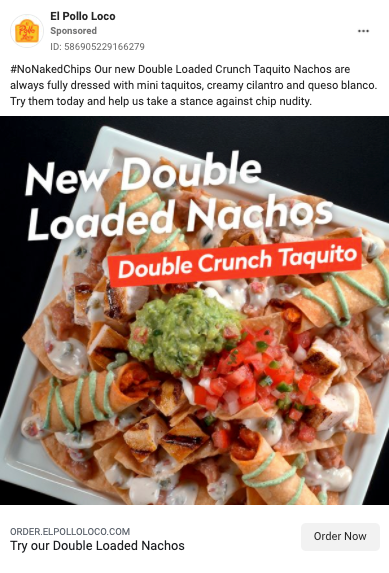
This El Pollo Loco ad is part of the brand’s #NoNakedChips campaign, a fun (and funny) way to present its new Double Loaded Nachos. It features an eye-catching photo, an appetizing description, a catchy hashtag, a memorable punchline, and, most importantly an Order Now button, so users can order directly from the ad.
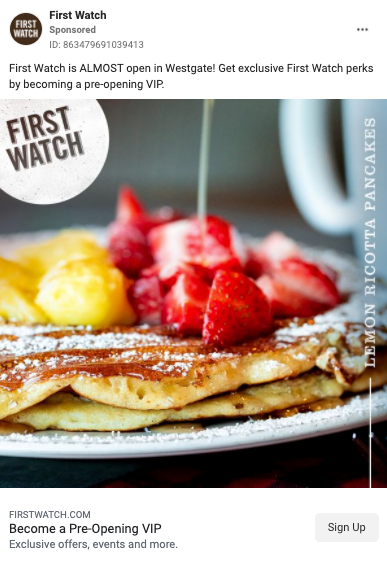
This First Watch ad targets guests located near its new restaurant location to boost brand awareness and generate excitement for the grand opening. The ad also drives email sign-ups by encouraging people to become a "pre-opening VIP."
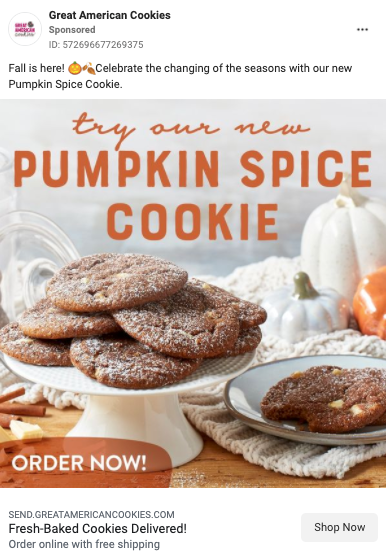
This Great American Cookies ad promotes new Pumpkin Spice Cookies. It creates a sense of urgency with a Shop Now button and succinctly explains that users can order online and have cookies delivered with free shipping.
With a data-driven social advertising campaign that leverages Lookalike Audiences, restaurants can lower their CAC and increase ROI.
2. Launch a Google Ads Campaign
According to Google, there are over one billion restaurant searches every month, and “food near me” is one of the fastest-growing search terms. Needless to say, Google advertising represents a huge (largely untapped) opportunity for restaurants to get in front of new guests searching for places to eat.
These Google Ad types can maximize your restaurant’s exposure: Search (text ads at the top of Google search results), Display (image ads on websites), and Video (YouTube ads).
All Google Ads can feature general messaging or promote seasonal offerings, events, catering, and more. They can even run during certain times of the day, like 10 a.m.-1 p.m. for the lunchtime rush or 3 p.m.-7 p.m. on date night, based on your current guests’ behavior.
How Restaurants Can Use Google Search Ads
- Rank above your competitors (e.g. Someone searches for your competitor and sees your ad above the link to their website)
- Target people searching for restaurants in your area (e.g. 10-mile radius of the restaurant)
- Bid on relevant keywords (e.g. “Italian restaurant Syracuse” or “Smoothie near me”) that potential guests are using in their search
Example of an Effective Google Search Ad
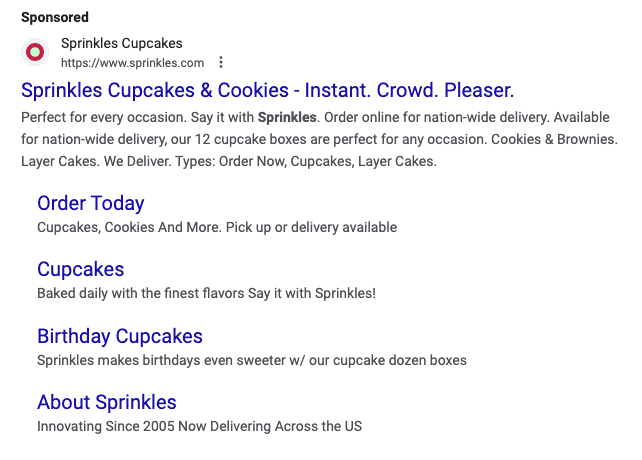
This Sprinkles Google Search Ad features a keyword-rich description that includes brand differentiators. Most importantly, users can easily order for pickup or nationwide delivery by clicking on the Google Ad extensions (webpage links) like “Order Today.”
How Restaurants Can Use Google Display Ads
- Catch the attention of potential guests with a compelling, on-brand visual
- Showcase your menu items and differentiators to users as they surf the web
- Promote your offerings on websites that focus on specific, related topics or keywords (e.g. A chicken wings ad on a fantasy football website before game day).
Example of an Effective Google Display Ad

This P.F. Chang's display ad is eye-catching and direct. It invites guests to order lunch by clicking the ad and features an irresistible tagline and image.
How Restaurants Can Use Video Ads
- Show off your menu and seasonal offerings to users who are searching for relevant keywords on YouTube or who are subscribed to certain channels (e.g. Eater, Food Insider, Bon Appétit, etc.)
- Take guests behind the scenes of your restaurant (e.g. cooking tutorials, meet the team, tour the kitchen, see the farm where the food originates, etc.)
- Viewers retain 95% of a message when they watch it in a video vs. 10% when they read it, so YouTube ads can ensure that your restaurant messaging is internalized
Examples of Effective Video Ads
This retro-style Lazy Dog Video Ad shines the spotlight on the restaurant’s new TV Dinners while evoking feelings of nostalgia. It’s short, sweet, informative, and leaves a lasting impression.
This Sonny’s BBQ Video Ad is fun and relatable and speaks to the desire to reconnect with friends and family during the pandemic. The ad shows off some menu offerings, while also appealing to our emotions.
With Google Ads, restaurants can:
- Increase online orders, phone orders, waitlist signups, and reservations
- Boost website traffic, phone calls, and foot traffic
- Extend your restaurant’s reach far beyond what your brick-and-mortar location and online listings can
- Generate brand awareness among locals and visitors
- Re-engage guests who haven’t visited in a while
3. Retarget Website and Social Media Visitors
If you’ve ever left a website without buying anything and then seen an ad for that company appear on your social feed or within your search results shortly thereafter, you’ve experienced retargeting.
With retargeting, brands can invite consumers back after they’ve visited their website or social page through hyper-relevant ads that follow the user as they browse the Internet. Given that these people have already expressed an interest in your brand, it’s easier and more cost-effective to advertise to them than to a non-retargeting audience.
How To Set Up Website Retargeting For Your Restaurant
To advertise to your website visitors with Google Ads, you’ll need to add a code snippet to your website: the global site tag and the optional event snippet. This will capture information about your visitors—pages viewed and actions taken—to create remarketing lists. For instructions, go here. Alternatively, you can enable remarketing with Google Analytics.
Once your website is tracking properly, it’s time to set up an audience source for your remarketing list in Google Ads. Your goals will determine who belongs on your remarketing lists. For example:
- Visitors of a page (e.g. Viewed catering options)
- Visitors of a page who did not visit another page (e.g. Viewed menu, but didn’t order)
- Visitors of a page during specific dates (e.g. Father’s Day weekend)
- Website visitors in the last 60 days
When you’re ready to launch your Google Ad, you’ll narrow your audience targeting to remarketing and select the appropriate list. For a breakdown of the setup process, check out this blog post.
Just imagine how powerful this kind of retargeting campaign would be if it were paired with a stellar automated email and SMS marketing strategy—now you’re thinking like a world-class restaurant marketer.
Facebook Retargeting For Restaurants
Facebook retargeting is another way to find people who have expressed interest in your restaurant—by visiting your website or engaging with your brand on social media—and make it easier for them to place an order.
To get started with Facebook retargeting, you’ll need to install a Facebook pixel—a small snippet of code—onto your website. This code lets Facebook track your guests and their actions on your site and social media. After you install the pixel, you can set up events to measure essential actions, like placing an online order.
Next, it’s time to create a Custom Audience on Facebook based on those actions, such as people who started an online order but didn’t checkout. Once your Custom Audience is built, you can create a campaign for your specific objective.
The Key To An Irresistible Restaurant Retargeting Campaign
Whether you use Google and/or Facebook, the key to driving conversions with retargeting is to create ads that are hyper-relevant to your audience and have a clear objective. If, for example, you’re retargeting people who visited your seasonal milkshake landing page last month, consider appealing to their sweet tooth.
There should be no guesswork involved when it comes to the CTA. Want someone to reorder or make a reservation? Make it abundantly clear and easy for them to follow through.
Examples of Effective Retargeting Ads
- Showcase popular menu items to people who engaged with your Instagram posts or ads in the last 30 days.
- Highlight a 5-star review in an ad that retargets your segment of guests who have passed their average frequency (a.k.a. Churn Risks).
- Gently remind people who abandoned an online order with messaging like: “Ready to order? Complete your purchase.”
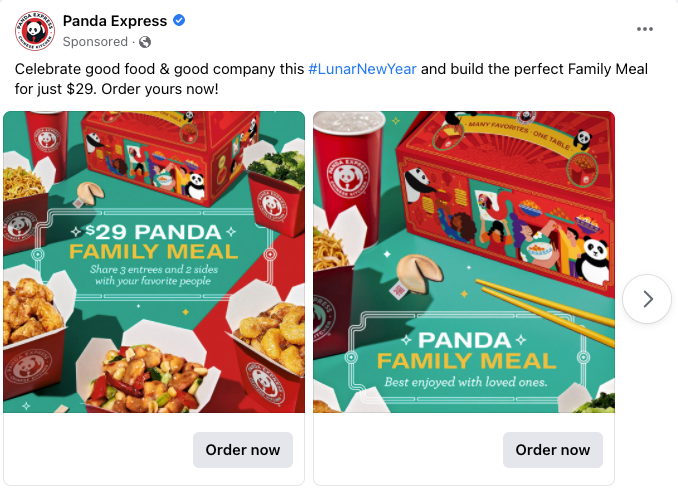
This Facebook retargeting ad from Panda Express promotes a family meal deal and gives guests the ability to Order Now from the ad. The copy and imagery are warm, inviting, and informative.

This is a Google Ad retargeting campaign for Athena Grill (a fictional restaurant created by Olo), which would retarget the restaurant’s website and social media visitors. It’s consistent in messaging, and branding, and has a clear CTA: Order Now.
Final Thoughts
No matter what strategy—or combination of strategies—you choose, remember that guest acquisition, just like restaurant marketing in general, is an iterative process. What works for your competitor may not work for your brand.
Expect to test different tactics and guest segments until you figure out what drives the most results. Keep an eye on impressions, clicks, cost, conversions, etc., and adjust accordingly.
Once you’ve found the sweet spot—the right platform, content that resonates, and high engagement—you’ll see your CAC drop. But don’t stop there. Keep your ads fresh so that they remain effective.
And, use your restaurant data as a guide. Top brands leverage guest data to reach consumers at just the right time, on their preferred channel, with relevant, personalized messaging based on their behavior.
Next up: The final installment of our Guide to Restaurant Guest Acquisition, in which we cover the importance of retention and outline ways to enhance the guest experience to drive long-term loyalty.
Learn more about Engage—Olo's restaurant-specific marketing platform—and request a demo to find out how Olo can help you attract new, high-value guests via targeted digital marketing campaigns.
Main photo credit: Vince Fleming

